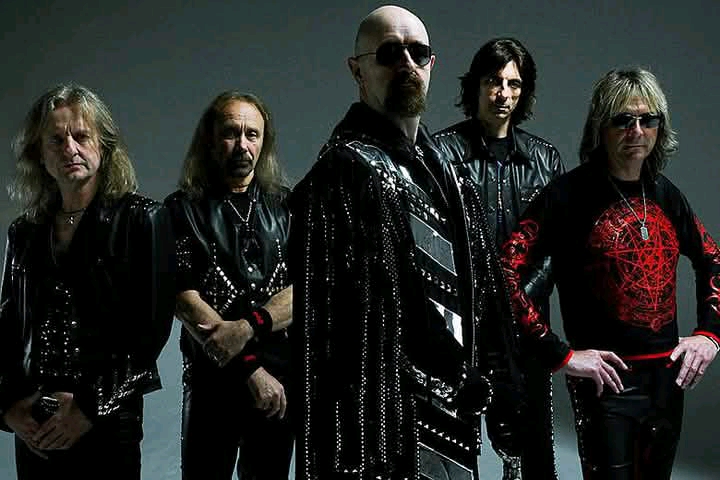“Forged in Steel: The Crimson Legacy of Judas Priest” (A Fictional Retelling)
By 1980, heavy metal stood at a crossroads. The furious energy of the ’70s had either burned out or spun into chaos. In smoke-filled clubs and neon-lit arenas, fans hungered for something both familiar and electrifyingly new. It was in this climate, in a gritty Birmingham rehearsal space reeking of grease and amplifier heat, that Judas Priest crafted an album that would reshape the steel-bound spine of metal itself—British Steel. But in this alternate tale, its success led to more than just commercial glory—it triggered a seismic cultural ripple that echoed through a fictional metal-obsessed America and beyond.
The year was 1980. Britain was groaning under Thatcherism, and America was still licking the wounds of the disco era. But when British Steel hit the shelves on April 14, it wasn’t merely another LP. It was a weapon—ten tracks of precision-forged sound, each one a blade honed to slice through the mainstream haze. What few knew then was that Rob Halford and company had struck a Faustian bargain in the backroom of a Sheffield music hall—a pact of pure rock alchemy. Legend has it that producer Tom Allom found an old war radio in the studio, tuned to a strange frequency. Each time it buzzed, Priest laid down another future classic.
“Living After Midnight,” with its turbocharged party riff and rebellious sneer, wasn’t just a hit—it became an anthem for a youth movement known as the Midnighters, a fictional fan army that would sweep across the U.S. like a biker gang possessed by Marshall stacks. Inspired by Priest’s newfound radio-friendly edge, these headbangers adopted leather uniforms, carried pocket-sized cassette players, and chanted lyrics as gospel. They believed metal was more than music—it was prophecy.
Meanwhile, “Breaking the Law” ignited something darker. Its siren-like riff and criminally catchy hook found fertile ground in a disenfranchised generation. In Detroit, a teenage garage band calling themselves The Verdict performed the song at a downtown rally—turning it into a protest anthem that sparked mock riots, fictional legislation, and even a satirical congressional hearing dubbed “The Steel Trials.” In this fictional America, lawmakers genuinely feared that Judas Priest had created a new language of rebellion—simple, repetitive, and utterly impossible to ignore.
The album’s deeper cuts—“Grinder,” “Steeler,” “Metal Gods”—became mythic among hardcore fans. Rumors swirled that “Metal Gods” wasn’t just a song but a code for an underground society of renegade musicians, each devoted to resurrecting ancient frequencies lost during the Great Vinyl Purge of ’77. Some believed Halford, with his booming operatic voice and leather-clad persona, was their high priest—a metal messiah born to lead the faithful into a new sonic age.
Backstage, the band changed. K.K. Downing, once a stoic axe-wielder, began crafting wild new guitar designs that supposedly harnessed harmonic distortion patterns to open interdimensional gates. Glenn Tipton, in this alternate history, was recruited by the MI6 Audio Division to develop sonic surveillance tools based on Priest’s tuning secrets. The government, intrigued by the hypnotic power of tracks like “Rapid Fire,” feared the band had stumbled upon aural weaponry.
Halford, meanwhile, became an underground icon across college campuses, appearing in fictional philosophy journals and dissertations. One student thesis titled “The Metallurgic Dialectic: Autonomy and Authenticity in British Steel” argued that the album was a postmodern critique of industrial capitalism disguised as arena rock. His lyrics, especially lines like “You don’t know what it’s like, you don’t have a clue,” were analyzed as existential manifestos.
With all this momentum, the British Steel Tour of 1980 became less a concert series and more a mass ritual. The Midnighters followed the band from state to state, holding midnight vigils and building massive steel effigies in parking lots, which they melted down in pyrotechnic displays that mimicked the sounds of “The Rage.” Cities like St. Louis and Cleveland became fictional metal meccas, hosting “Steel Cons” where fans debated whether British Steel was merely inspired by the working class or secretly dictated by a metallurgic deity.
Corporate America, always a step behind, tried to capitalize. A fictional cola brand, Molten Maxx, launched with a Priest-endorsed jingle. Clothing chains released studded fashion lines based on Halford’s stage gear. A heavy metal Saturday morning cartoon called Steel Crusaders aired briefly before being pulled due to “excessive volume and influence on behavior.”
But not all was triumphant in this alternate tale. As with any myth, darkness crept in. Some fans went too far, forming radical splinter cells called The Lawbreakers, who staged pranks and protests across America using the slogan “Don’t Go Easy—Go Priest!” A fictional news channel dubbed them the “Metal Militia,” and suddenly, heavy metal became a national concern.
Despite the backlash, Judas Priest pressed on. The success of British Steel allowed them to unlock budgets and creativity never before imagined. In a now-lost follow-up album (fictionally titled Molten Code), they explored science fiction themes, guitar algorithms, and vocal frequencies that could allegedly simulate empathy. The album was banned in three fictional states after a church choir in Nebraska went spontaneously glam after one listening.
Years later, as music splintered into ever-nicher genres, the cultural historians of this alternate timeline looked back at British Steel not just as a commercial success—but as a singular moment when heavy metal intersected with the collective unconscious. It was an album born of factories and sweat, forged in imagination, and delivered with uncompromising clarity.
In the end, British Steel became more than an LP—it was a lodestone, pulling in the wild magnetic currents of the world’s sound and channeling them through twin guitars, screaming vocals, and pounding drums. In this fictional universe, it didn’t just change Judas Priest’s trajectory—it rewired music history itself.
Would you like an alternate version written in a different tone (e.g., documentary-style, noir, or comedic)?









